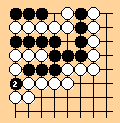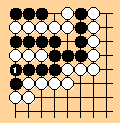The Japanese Rules
[The following is the formulation of the Japanese rules of go in their entirety as revised on April 10, 1989 and effective from May 15, 1989.]
The Nihon Ki-in and Kansai Ki-in hereby revise the Nihon Ki-in's Rules of Go formulated in October 1949 and establish the Japanese Rules of Go. These rules must be applied in a spirit of good sense and mutual trust between the players.
Commentary on the Japanese Rules
Remarks and clarifications
The text in this column is coloured to indicate who wrote it: Fred Hansen, Robert Jasiek and Nick Wedd.For a fuller commentary, see Commentary on the Japanese 1989 Rules.
2. To declare that the game should stop, a player passes. If his opponent passes in succession, the game stops and neither player can play next. (See Article 9, clause 1.)
1. Being for professional players, these rules stipulate a 19 x 19 board.
The players may of course agree to use other boards, such as a 9 x 9 beginners' board, a 13 x 13 board, or (in the future) a 21 x 21 board.
2. Intersection, empty point, and point of play
There are 361 intersections like that at 1 in Diagram 1. An intersection on which no stone has been placed is called an empty point. An intersection on which a stone like 1 has been placed is called its point of play.
Diagram 1. Intersections on the board.
3. Empty points that cannot be played on because of Article 4
A player cannot play a move that would deprive his own stones of liberties, so that they could not exist on the board. For example, Black cannot play at any point marked x in Diagram 2. Note that Black can play at A because the resulting black group would have a liberty.
Diagram 2. Black cannot play at x, but can play at A.
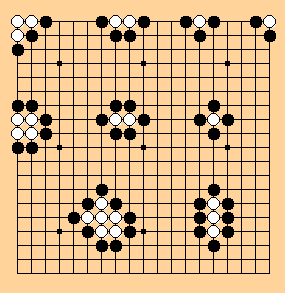
Diagram 3. Stones that cannot exist on the board
1. Shapes in which the players can alternately recapture one opposing stone
In Diagram 5a, Black can capture the triangled white stones with move 1, and White can recapture Black 1.a
 b
b 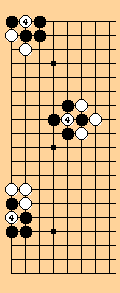
Diagram 5 Kos.
2. Prohibition of recapture on the next move
After Black 1 in Diagram 5a, White cannot play at 4 in Diagrams 5b to recapture unless he first plays at least once elsewhere. A move played elsewhere for this purpose is called a "ko threat."
3. If a player recaptures on the next move without making a ko threat, he forfeits the game (Article 14).
1. When the game stops, ko recapturing also stops.
Even if a player has unlimited ko threats (in a double-ko seki for example), he cannot use them to recapture a ko. Diagram 9 is an example of prohibition of recapture in a direct ko.
Diagram 9
Black does not play A and claims that the game has ended. What happens? If the game ends in this way, the black group and the white stone are both dead. See Life-and-Death Example 9, below. It is clear the white stone is dead because Black can capture it by playing at A. The black stones are dead because when White captures by playing at B, Black must pass for that ko and then White captures the six remaining black stones by playing at A.
2. If a player whose stone has been captured in a ko has passed for that particular ko
, the situation for that ko is the same as if the game had been resumed: the player may now capture in that ko again.
Diagram 10 Approach-move ko: an example of capturing again after passing.
The question in Diagram 10 is whether the game can end without Black's playing at A. The answer: If White does not actually fight the ko and the game ends in this position, the eight black stones are alive and the white stone is dead. Black does not have to add a move at A. See Life-and-Death Example 10.
3. Approach-move ko with double-ko seki (example of capturing again after passing for that particular ko capture).
Suppose positions in Diagram 11 are both present on the board. The question is whether the game can end without Black's playing at A. The answer: If the game ends in this way, the white stone is dead despite the double ko in the position at the right. Black does not have to add a stone at A.
Diagram 11.
The reason the white stone is dead is as follows.
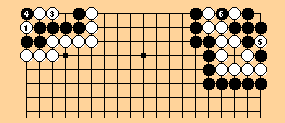
White 1 takes ko (on left) and Black 2 passes because recapturing is prohibited except after passing. White 3 gives atari. Black 4 retakes ko, a legal play because Black has passed once for this ko (in lieu of Black 2). White 5 takes a ko on the right and Black 6 takes the other ko. White 7 passes for the left ko, because recapturing without first passing is prohibited.

Black 8 captures two white stones on the left. White 9 and Black 10 pass for kos on the right. White 11 takes ko; this is legal because White has passed at play 9. Black 12 takes ko; this is legal because Black has passed at play 10.
Note that if White 7 was a pass for the ko 6/11 on the right, Black could have played 8 at 12 and captured the white group on the right. White could still not capture on the left and that Black group would remain alive.
1. Examples of stones that are alive because they cannot be captured by the opponent.
All the stones in Diagram 6 are alive.
Diagram 6. Live stones. (The lower right stones are alive in seki, Article 8.)
2. Examples of stones that are alive because capturing them would enable a new stone to be played that the opponent could not capture.
In Diagram 7 White can capture Black on the next move at any of the x points, but Black can then play a stone that White cannot capture. This is known as a snapback. The black stones are therefore alive.
Diagram 7. Examples of snapback
(Note that the definition of "stones that cannot be captured" is recursive. The two black stones on the right are alive because when White captures them it enables Black to play as shown on the left. The black stone on the left is alive because when White captures it Black can recapture.)
3. Examples of dead stones
The black stones in Diagram 8 are all dead.
Diagram 8. Dead stones. The black stones are dead. Clause 2 of Article 7 states how to settle unclear questions of life or death involving ko after the game stops (see Article 9, clause 1).
1. Eyes and territory
Points a to d in Diagram 12 are eye points. The Black group surrounding them is completely alive, so they are territory.
Diagram 12. Eye Points.
2. Seki and dame
Point a, in Diagram 13, is a dame. The ten black stones and four white stones are live stones with dame, so they are alive in seki. The points marked x are eye points but are not territory because the surrounding group is alive in seki.
Diagram 13. Seki and Dame.
3. Double ko seki
In Diagram 14, points a and b are dame because they are not surrounded by live stones of one player. The six black and twelve white stones are live stones possessing dame, so they are alive in seki. (See Life-and-Death Example 25 for details.) The points marked x are not territory because they are surrounded by stones that are alive in seki.
Diagram 14. Double-ko seki.
4. Filling in the dame to confirm territory
In the position in Diagram 15, the black and white groups are both alive, but in seki because of the dame at A, so neither side has any territory. A move at A is needed to make Black's and White's eyes into territory.

Diagram 15.
"Stones which are alive but possess dame are said to be in seki".
It is not obvious what is meant here by "stones". There are three possibilities:
 Consider this position.
It is clear that the intention of this rule is that the corner
point is not territory (even though the adjacent strings have no
dame). We can conclude that sense 3 is intended.
This position is due to William Brooks.
Consider this position.
It is clear that the intention of this rule is that the corner
point is not territory (even though the adjacent strings have no
dame). We can conclude that sense 3 is intended.
This position is due to William Brooks.
In the Hansen/Cano online version of this document, the stone at a15 in diagram 14 is shown as black. It should be white, and is shown as white in both editions of the "Go-Player's Almanac". This error was pointed out by William Brooks.
2. If the players agree, they may fill the dame and add other necessary stones after stopping the game, in which case these are not moves as defined by the rules, and need not be played according to the rules.
1. "If a player requests resumption..."
The game is released from its stopped state and competition resumes.
2. "...his opponent...has the right to play first."
a. If a game is resumed, any moves played not in accordance with the rules during the period when the game was stopped are invalid.b. Arguments over who plays first are resolved by stating that the opponent of the player who requests resumption may play first.
3. "...his opponent must oblige..."
If the opponent does not see any need to play, he may pass.Resumption is hardly ever used explicitly, as few players are aware of its presence in the rules. It is frequently used implicitly, as when after the game stop a player indicates a teire and says "I will have to play here."
"If a game is resumed, any moves played not in accordance with the rules during the period when the game was stopped are invalid" .. and are presumably removed from the board.
1. Example of a stone that can be removed as is after the end of the game.
After the end of the game, the white stone in Black's territory in Diagram 16 is dead, so Black can remove it without further play.
Diagram 16
2. Example of stones that cannot be removed as is after the end of the game
The black stones marked with triangles in Diagram 17 are dead, but White is alive in seki, so the points are not his territory. White therefore cannot remove these two black stones as is.
Diagram 17
Note: Before the end of the game, White can play A to capture the two black stones, then capture another stone which Black has to throw in.
Articles 1, 2, 9, and 10 are illustrated below


I disagree with [the above] flowchart...
Japanese professional (and amateur) playing practice tells us that in
between the game stop and the actions of [Article] 10 something happens that is
neither an explicit "confirmation and agreement by the two players
about the life and death of strings and territory" nor an explicit
reaching of the game end but an either formal, alternating or
non-formal, possibly not alternating filling of still unfilled so
called two-sided dame and so called teire.
1. Examples of repetition of the same whole-board position
This may occur in a triple or higher-order ko, round-robin ko, long life, etc. ee Diagrams 18.

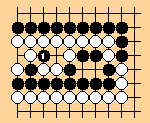

Diagram 18. Triple ko, round-robin ko, and long life
2. "...if the players agree, the game ends without result."
In consideration of the difficulty of checking the repetition cycle, the game ends without result if both players agree.
I understand the intention of this article as being that the players may repeat a position two or three times without effect, and then play some other line to break the cycle. But if it becomes clear to both that neither is going to break away from the cycle, then the game ends without result.
In Japan, "without result" means that the game was a non-event, and must be
replayed, possibly with faster time limits. This is not appropriate for the
usual conditions of British Go events. In Britain, games that end in this
way are treated as jigo (the precedent is the game Ellul-Herman in the Welsh
Open 1996).
What would happen in the the British Championship best-of-five playoff match if
one player had two wins, the other had one win, and two games ended with triple-ko?
In the positions in Diagrams 19, after the game has stopped both players discover effective moves at A. Suppose both players would lose if their opponent played A, so neither requests resumption of the game. Then if the players do not agree that the game has ended, both players lose.
a b
b
Diagram 19.
This clause does not make sense. "The players find an effective
move .. and therefore cannot agree to end the game". The "therefore"
clause does not follow. The players do not disagree about anything.
They have passed, the game is coming to an end, it remains to confirm
the statuses of the groups and score the game. The fact that the players
are now aware that they had effective moves when they passed does nothing
to delay this process.
This clause is unnecessary. Preceding articles specify how
positions such as those in diagram 19 are to be scored.
This clause seeks to punish players who have done nothing wrong.
Its application will make the players unhappy. Their only crime is to
have played imperfectly. Players should not be punished for making bad
moves, beyond the in-game consequences of those moves.
I recommend ignoring clause 13.1. I shall do so myself.
In diagram 19a the black
stones cannot be killed, and therefore are alive. They have no dame,
and therefore are not in seki. They surround seven points of territory.
In diagram 19b the white
stones can be killed, and so are dead. They are removed from the board.
Black has fourteen points of territory there and nine prisoners.
1. Note that if the game were to continue as is, it would not be possible to make a game record.
2. Note that the reason for having both players lose is that if the game were declared to end without result, a player who found himself behind might move stones intentionally.
"If the game were to continue as is, it would not be possible to make a game record": nonsense, it doesn't seem any harder than recording a ko fight.
1. If an illegal move has been played
and the result of the game has not yet been confirmed, the game is forfeited at the point of the illegal move. Note: If the violation is discovered after the result has been confirmed, according to Article 10 clause 4, the result does not change.
2. Examples of illegal moves:
playing twice in succession; capturing in a ko without making a ko threat.- The players
- The referee, or a sufficiently strong player or players appointed by the referee
View 2 is favoured by some members of the European Go Association. It is supported by the existence of the many "Examples of Confirmation of Life and Death" below – material which is likely to be studied by referees but by few players.
Personally I favour view 2. A need for confirmation is most likely in games between weak players, and I, as referee, do not want to have to the task of explaining Article 7 Clause 2 (the "pass-for-ko" rule) to 25-kyu players.

If the game ends as shown in the diagram, the white stone and the four black stones are both alive. By Article 8, the position is a seki.
The black stones are alive in the confirmation phase as follows:
-

White plays 1 to capture 4 black stones.

Black is now able to play 2, a stone which cannot be captured.
The four black stones are alive because capturing them enables the play of a stone (2) which is alive (in that it itself cannot be captured).
The white stone is alive in the confirmation phase as follows:
-

Black 1 captures a white stone.

White 2 recaptures.

Black plays 3 and white 4. Black captures with 5. White can play 6.
Caturing the one white stone enables the play of two white stones at 4 and 6 which cannot be captured, so the original white stone is alive.
Before the end of the game, either Black or White can play A to resolve the position by actual play.
If White plays A
first, capturing four black stones:
-

Black plays 2. White plays 3. Black 4 captures three white stones.

White plays 5. Black 6 connects at the left of 2 (or plays at the left of 3 for a ko). White 7 captures a black stone (or begins the ko fight).
White captures 5 black stones; Black captures 3 white stones; White gains 2 points. (If Black plays and wins the ko, White gains 1 point.)
If Black plays A first (capturing a white stone)
-


White plays 2, capturing five black stones. Black plays 3. White plays 4.

Black plays 5, capturing a white stone. White 6 connects (or White starts a ko fight). Black 7 fills at 2 (or responds to the ko threat).
White captures 5 stones and Black captures 2; White gains 3 points. (If white plays and wins the ko, White gains 7 points.)

This position is a seki. Black does not have to play A.
Reason why the two black stones are alive:

If White captures Black's two stones, Black can play two new stones (at 2 and 4) which White cannot capture. Since there is a dame, the position is a seki.

Black and White are both alive. By Article 8, the position is a seki. Neither player will play at A.
If White captures by playing at A,
Black will capture the entire corner.
Or if Black captures by playing at A
Black cannot avoid losing the entire corner. (Making responses to 2 and 4 is no better.)
Since neither player plays at A, the position remains as in the original diagram. It is a seki because there are dame.

Black and White are both alive. By Article 8, the position is a seki. Black can gain 9 points by capturing one of the white groups before the end of the game instead of leaving the position as a seki.
Black gets 8 prisoners and 9 points of territory, while White gets 6 prisoners and 2 points of territory.

The enclosed black and white stones are all alive. By Article 8, the position is a seki.
If Black tries to capture White before the end of the game he loses one point: Black gets 5 prisoners and 3 points of territory while White gets 7 prisoners and 2 points of territory (ignoring the possibility of a ko). If White begins he can gain 1 point, getting 7 prisoners and 3 points of territory while Black gets 6 prisoners and 3 points of territory.

The diagram shows a position one move prior to the start of a long life. Black A would create long life (cho sei), causing the game to end without result. Suppose that White would lose by half a point if he played A. The question is what happens if the game ends with neither player playing A.
Black's ten stones are dead because they die if White plays A. White's four stones are alive because even if Black plays A, they survive in the ensuing long life. Black's ten stones are therefore dead stones in territory surrounded by live white stones. If the game ends as shown, White can remove the ten black stones as is, without having to play A.

The three black stones are alive and the seven white stones are dead.
Here is how Black can demonstrate capture of the white stones during the confirmation phase:
-

Black plays 1. White plays 2, capturing four stones.

Black plays 3. White plays 4. Black plays 5, capturing ina ko. White 6 passes (a pass is required bfore recapturing). Black 7 captures eight white stones.

The bent-four-in-the-corner of Life-and-Death Example 7-1 is dead even if a thousand-year ko, as shown here on the right, is also present on the board. Here is how Black can demonstrate capture of the seven white stones on the right, during the confirmation phase:
-

Black plays 1 and White plays 2, capturing four stones.

Black plays 3, White plays 4, and Black takes the ko at 5. White 6 is a ko threat in the thousand year ko. Black captures the righthand ko by playing at 7.

White 8 is a pass for the ko on the left and Black 9 takes eight white stones. White 10 passes for the ko on the right and Black 11 captures four white stones. (If White 8 had been the pass for the ko on the right, Black would have played 9 at 11.)

Black's nine stones are dead and White's ten are alive.
In the confirmation phase, the black stones can be captured as follows.
-

White 1 takes the "outside" ko. Black 2 takes an inside ko. White 3 takes the other inside ko. Black 4 passes (for either the ko at 1 or 3). White 5 captures nine black stones.

If the game ends like this, Black and White are both dead but none of the stones can be removed. According to Article 8 there is no territory. Compared with playing A, Black loses 3 points.
White's stone is clearly dead because Black can capture it at A. The
reason why Black's seven stones are dead is as follows.
-


In the diagram at left, White takes ko at B, Black passes (he cannot recapture before passing), then White A captures six black stones.

The question is whether Black has to play A before the end of the game. The answer: If White does not actually play out the ko and the game ends as shown, White's stone is dead, the eight black stones are alive, and Black does not have to play A.
Black's eight stones are alive for the following reason:
-
-

White 1 takes ko.
Black 2 passes (recapturing without first passing is prohibited).

White plays 3.
Black 4 recaptures the ko (legal because Black has passed).

White 5 passes (recapturing without first passing is prohibited).
Black 6 captures two white stones.
-

If both these positions are present on the board, the seven white stones on the left are dead while the enclosed black and white groups on the right are both alive in double-ko seki.
Here is why the seven white stone are dead:
-

Black 1 takes ko on the left. White 2 takes ko on the right. Black 3 takes the other ko on the right. White 4 passes for the ko on the left. Black 5 captures the seven white stones on the left. White 6 passes for the right and Black 7 passes for the other ko on the right.

If the game ends with this position on the board, Black and White are both alive in seki. By Article 8, the position is a seki.
Why Black cannot kill the white stones:
-
-

Black 1 takes the ko. White 2 passes (no choice). Black plays 3.

White 4 takes ko. Black 5 passes (no choice). White 6 captures nine black stones.
-
The result through White 6 shows that White is alive if Black plays
first. If White plays first to try to kill the Black group, it lives
in the following sequence through Black 4.
-

White plays 1. Black 2 takes ko. White 3 passes (recapturing without first passing is prohibited). Black 4 captures five white stones.

Black and White are both alive. By Article 8, the position is a seki.
Here is why Black cannot kill White:
-

Black plays 1. White 2 captures three black stones.

Black 3 recaptures White 2. White 4 passes (or plays at x.)

Black plays 5, which is not a ko capture. White 6 takes ko. Black 7 passes. White 8 takes another ko. At 9, Black must pass for the second ko. White 10 captures the last two black stones.

The eight black stones are alive and the seven white stones are dead. To gain a seki, white has to play at A.
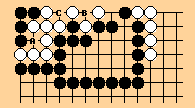
The four black stones are alive and the eleven white stones are dead.
Note: This question arises if White has no ko threats and the
game ends with neither player making a move. White does not play
A to start the ko because he would lose.
Black does not play B and
C to capture the white stones because
this would cost him two points.
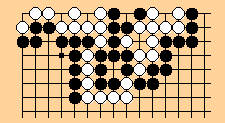
The ten white stones in the left corner are dead. The eleven white stones to the right also die through collapse of the seki.
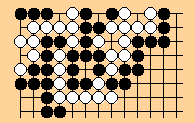
The three black stones in the corner are alive. The ten white stones surrounding them are dead. The eleven surrounded white stones to the right also die through collapse of the seki.

The seven black stones in the corner are dead. The black group in the center dies through collapse of the seki.

White is alive and Black is dead.

White and Black are both alive. By Article 8, the position is a seki.
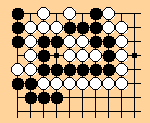
The nineteen black stones are alive and the fourteen white stones are dead.

The seven black stones are alive and the ten white stones are dead. Black does not have to add a move to capture the three white stones.
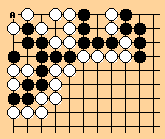
From Article 7 clauses 1 and 2 and the purpose of the game stated in Article 1, Black is alive and White is dead. If White plays A before the end of the game, the position becomes a seki, but Black can capture 9 white stones while White captures 1 black stone.
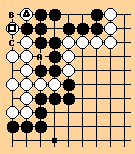
a. In this position, the black and white groups are both alive, but in seki because of the dame at A, so neither side has any territory. A move at A is needed to make Black's eyes into territory.
b. If there is a double-ko seki on the board, White can fight the kos at B and C. From Article 7, the triangled white stone is dead and the squared white stone is alive, so B is a dame and C is an eye.
c. Even if the dame at A is filled, White is alive in seki because of the dame at B, so White's two eyes and the point C are not territory. To get two points of territory, White must play at B and C.
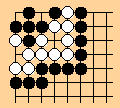
a. Black's five-stone group and White's eleven-stone group are alive but have dame at A and B. By Article 8, they are alive in seki.
b. The reason A and B are dame is as follows.
-
(1) After the single black and white stones in the kos are captured.new
black and white stones can be played, but these new stones are not
uncapturable. The single black and white stones in the kos are therefore
dead.
(2) Although A and B are empty points surrounded by stones of just one player, the surrounding stones include both live and dead stones. By Article 8, A and B are therefore dame, not eye points.

